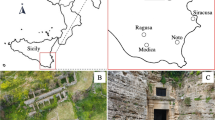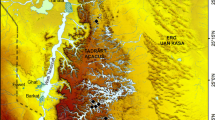Abstract
An assemblage of approximately 500 colouring materials and objects related to their use, found in different contexts and forms at Akrotiri, Thera, was recently investigated. The items date to the Early, Middle and Late Cycladic Bronze Age (c. 3000–1600 bc) and include materials or pigments found in their natural state, in specifically made forms or inside vessels. Some of the contexts do not provide any indication of the pigments’ use, storage, trade or application. Among the investigated materials, which include red and yellow ochres and blue riebeckite, are those that can be associated with pigments that were widely used in the past in wall paintings or to decorate pottery. There is also evidence for the selective use of purple pigments, which were derived from shellfish, in wall paintings. However, there are other raw colouring materials, such as lead pigments that have not been previously known to have been used in wall paintings or in any other applications during the prehistoric period in the Aegean. A thorough macro- and microscopic visual examination of the quality and morphology of these items enabled the identification of physical features (colour, homogeneity, grain size and shape) that indicate their nature or degree of processing. To identify the mineral composition of the pigments and to investigate their provenance from a geological perspective, quantitative X-ray diffraction (XRD) analysis was conducted. For those samples requiring additional information on their composition and for the refining or confirming of the XRD data, scanning electron microscopy combined with energy dispersive X-ray spectroscopy (SEM-EDX), micro-Raman and Fourier transform infrared (FT-IR) spectroscopies were performed. This work is part of a larger project, supported by Institute for Aegean Prehistory, that aims to clarify major archaeological queries that are not restricted to the identification of the nature, composition and provenance of the colouring materials but extend to aspects of their selection, preparation and application techniques used during the Early to the Late Bronze Age.










Similar content being viewed by others
Notes
Marl is a natural mixture of clay, sand and limestone in varying proportions; it is soft and crumbly.
Al occupies tetrahedral sites, replacing Si and octahedral sites; Alvi is the Al content in octahedral sites.
References
Aloupi E, Maniatis Y, Paradellis T & Karali-Yannacopoulou L (1990) Analysis of a Purple Material Found at Akrotiri. In: Thera and the Aegean World III, vol. I, pp. 488–490
Asimenos, K. (1978) Observations on Thera wall-paintings. In: C. Doumas (ed.) Thera and the Aegean World II. Papers and Proceedings of the Second International Scientific Congress, Santorini, Greece, August 1978, The Thera Foundation, London, pp. 571–578
Bassiakos Y, Kilikoglou V, Vassilaki-Grimani M, Grimanis AP (1990) Provenance studies of Theran lead. In: Hardy D, Keller J, Galanopoulos VP, Flemming NC, Druitt TH (eds) Thera and the Aegean World III, 2. The Thera Foundation, London, pp 337–345
Birtacha, V., Sotiropoulou, S., Perdikatsis, V., Apostolaki, Ch. (2007) Chromata. Protes yles kai endeixeis gia tin epexergasia kai ti xrisi tous. Akrotiri, Thera. In: Saranta chronia ereunas (1967–2007), Epistimoniki Synantisi, Athens, 15–16 Dekembriou 2007
Cao X, Wahbi A, Ma LQ, Li B, Yang Y (2009) Immobilization of Zn, Cu, and Pb in contaminated soils using phosphate rock and phosphoric acid. J Hazard Mater 164:555–564
Casas JM, Paipa C, Godoy I, Vargas T (2007) Solubility of sodium-jarosite and solution speciation in the system Fe(III)–Na–H2SO4–H2O at 70 °C. J Geochem Explor 92:111–119
Chrysikopoulou, E. and Sotiropoulou, S. (2003) To iodes stin paleta tou Thiraiou zografou, Τ. In: Α. Vlachopoulos, K. Birtacha (eds.) Argonaftis. Timitikos tomos gia ton kathigiti Xr. G. Douma, Αthens, pp. 490–504
Desborough G, Kathleen S, Heather A, Lowers H, Swayze G, Hammarstrom J, Diehl S, Leinz R, Driscoll R (2010) Mineralogical and chemical characteristics of some natural jarosites. Geochimica et Cosmochimica Acta 74:1041–1056
Devetzi Α (2007) Lithina ergaleia kai skeui gia tin epexergasia anorganon ylikon, in: Saranta chronia ereunas (1967–2007). Epistimoniki Synantisi, Athens, 15–16 Dekembriou 2007
Doumas C (1992) Wall paintings of Thera. Thera Foundation, London
Drouet C, Navrotsky A (2003) Synthesis, characterization, and thermochemistry of K–Na–H3O jarosites. Geochimica et Cosmochimica Acta 67:2063–2076
Filippakis, S.E. (1978) Analysis of pigments from Thera. In: C. Doumas (ed.) Thera and the Aegean World II. Papers and Proceedings of the Second International Scientific Congress, Santorini, Greece, August 1978, The Thera Foundation, London, pp. 599–604
Filippakis S, Perdikatsis V, Paradellis Th (1976) Analysis of blue pigment from the Greek Bronze Age. Stud Conserv 21:143–153
Groppo C, Forster M, Lister G, Compagnoni R (2009) Glaucophane schists and associated rocks from Sifnos (Cyclades, Greece): new constraints on the P-T evolution from oxidized systems. Lithos 109:254–273
Helwig, K (2007) Iron Oxide Pigments (natural and synthetic). In: B Berrie (ed.) Artists’ pigments—a handbook of their history and characteristics, vol. 4, pp. 39–95
Katagas CH (1974) Alkali amphiboles intermediate in composition between actinolite and riebeckite. Contr Mineral Petrol 46:257–264
Mignardi S, Corami A, Ferrini V (2012) Evaluation of the effectiveness of phosphate treatment for the remediation of mine waste soils contaminated with Cd, Cu, Pb, and Zn. Chemosphere 86:354–360
Papadimitriou, GD (1995) Litharge: a useful byproduct of the metallurgy of silver in ancient Laurion. In: Praktika tis VI Epistimonikis Synantisis Notioanatolikis Attikis, Markopoulo, 21–24 Oktovriou 1993, Pneumatiko Kentro Dimou Markopoulou, pp. 234–265
Perdikatsis, V, Kilikoglou, V, Sotiropoulou, S and Chryssikopoulou, E (2000) Physicochemical characterisation of pigments from Theran wall paintings. In: Sherratt, S. (ed.), The wall paintings of Thera, vol. 1, Athens, pp. 103–118
Serna C, Cortina CP, Garcia Ramos J (1986) Infrared and Raman study of alunite–jarosite compounds. Spectrochimica Acta Part A: molecular Spectroscopy 42:729–734
Skarpelis, N. and Liati, A., 1990. The prevolcanic basement of Thera at Athinios; metamorphism, plutonism and mineralization. In: D.A. Hardy, J. Keller, V.P. Galanopoulos, N.C. Flemming and T.H. Druitt (eds.) Thera and the Aegean World III, vol. 2: Earth Sciences. Proceedings of the Third International Congress, Santorini, Greece, 3–9 September 1989, The Thera Foundation, London, pp. 172–182
Sotiropoulou S (2005) La pourpre dans l’art cycladique: identification du pigment dans les peintures murales d’Akrotiri (Thera, Grece). Preistoria Alpina 40(suppl 1):167–176, 2004
Sotiropoulou, S and Karapanagiotis, I (2006) Conchylian purple investigation in prehistoric wall paintings of the Aegean area. In: L Meijer, N Guyard, A-L Skaltsounis, G Eisenbrand (eds) Indirubin, the Red Shade of Indigo, chapter 7. Life in Progress Editions, Roscoff, pp. 71–78
Sotiropoulou S, Perdikatsis V, Apostolaki Ch, Karydas AG, Devetzi A, Birtacha K (2010) Lead pigments and related tools at Akrotiri, Thera, Greece. Provenance and application techniques. J Archaeol Sci 37:1830–1840
Stos-Gale ZA, Gale NH (1990) The role of Thera in the Bronze Age trade in metals. In: Hardy DA, Doumas CG, Sakellarakis JA, Warren PM (eds) Thera and the Aegean World III, 1. The Thera Foundation, London, pp 72–89
Westlake P, Siozos P, Philippidis A, Apostolaki CH, Derham B, Terlixi A, Perdikatsis V, Jones R, Anglos D (2012) Studying pigments on painted plaster in Minoan, Roman and Early Byzantine Crete. A multi-analytical technique approach. Anal Bioanal Chem 402:1413–1432
Acknowledgments
The authors would like to thank Professor Christos Doumas, director of the Excavations at Akrotiri, Thera, for his permission to publish and for his support of this study. This research was supported by a research grant (2006–2010) from the Institute for Aegean Prehistory. Micro-Raman measurements were performed at the Laboratory of Dynamics, Interactions and Reactivity LADIR, UMR 7075 CNRS/UPMC, Campus CNRS, Thiais. Special thanks are owed to Dr. Ludovic Berlot-Gurlet for his invaluable assistance and support. The results included in this paper were preliminarily presented at the ICASEMNE international conference in Paphos (May 2010, Cyprus).
Author information
Authors and Affiliations
Corresponding author
Rights and permissions
About this article
Cite this article
Sotiropoulou, S., Perdikatsis, V., Birtacha, Κ. et al. Physicochemical characterization and provenance of colouring materials from Akrotiri-Thera in relation to their archaeological context and application. Archaeol Anthropol Sci 4, 263–275 (2012). https://doi.org/10.1007/s12520-012-0099-y
Received:
Accepted:
Published:
Issue Date:
DOI: https://doi.org/10.1007/s12520-012-0099-y




